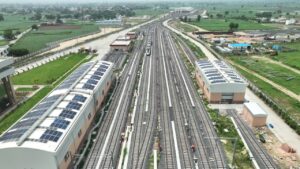The National Capital Region Transport Corporation (NCRTC) has invited bids for a 110 MW grid-connected solar PV project in Uttar Pradesh. The plant will supply 60% of the energy requirement of the Namo Bharat Corridor and aligns with the sustainable goal of India for the transit system. The development will cut down costs, reduce carbon emissions, and strengthen NCRTC’s commitment to green energy.
Introduction:
In a significant move towards sustainable development in the RRTS corridor, National Capital Region Transport Corporation (NCRTC) has initiated an online bid for the establishment of a 110 MW (AC) grid-connected solar PV power project in Uttar Pradesh. The initiative aligns with India’s larger renewable energy objectives and NCRTC’s mission to integrate green energy solutions into regional transport systems.
The electricity generated will be dedicated to powering trains, stations, and other operational requirements of the Delhi–Ghaziabad–Meerut Namo Bharat Corridor. With energy constituting around 30–35% of the corridor’s operating expenses, this project is expected to drastically lower costs and enhance energy self-reliance.

Meeting Energy Demands with Renewables:
The solar plant will operate in captive mode, exclusively serving NCRTC’s requirements. Once commissioned, it is projected to meet up to 60% of the corridor’s total power demand. This initiative will be undertaken in partnership with a government entity through a joint venture, allowing flexibility to establish the plant at any suitable location in Uttar Pradesh.
In addition to the large-scale solar project, NCRTC has also planned rooftop solar plants across stations, depots, and receiving substations, expected to generate an additional 15 MW. Together, these initiatives reflect a long-term target of meeting 70% of the corridor’s total energy requirement through clean, renewable sources.
Environmental Benefits:
This initiative is not only about operational savings but also about environmental responsibility. The solar plant is estimated to reduce approximately 177,000 tons of carbon dioxide (CO2) emissions annually. By decreasing reliance on fossil fuels, it will also help mitigate air pollution caused by nitrogen oxides (NOx) and sulfur dioxide (SO2), pollutants commonly linked to coal-based power generation.
Key Benefits at a Glance:
- Reduction in Carbon Footprint: Annual CO2 emission reduction of nearly 177,000 tons.
- Promotion of Renewable Energy: Strong alignment with the National Solar Mission and India’s green energy roadmap.
- Air Quality Improvement: Elimination of harmful emissions compared to conventional coal power.
- Operational Efficiency: Reduction of long-term electricity costs by nearly one-third.
Power Distribution and Grid Integration:
The electricity from the solar power project will be connected to the Uttar Pradesh state grid and supplied directly to the corridor’s receiving substations (RSS). From there, it will be distributed to trains and other critical facilities, ensuring a stable and reliable energy supply.
Driving Sustainable Urban Transport:
NCRTC’s tender for the 110 MW solar plant is a strong testament to its vision of combining modern mobility with environmental stewardship. The initiative reinforces NCRTC’s role in promoting sustainable transport while aligning with national renewable energy policies. By integrating large-scale solar power, the Delhi–Ghaziabad–Meerut Namo Bharat Corridor is set to become a benchmark for eco-friendly rail systems in India.
Conclusion:
NCRTC’s plan for a 110 MW solar power project marks a major step towards sustainable regional transport. By meeting 60% of the corridor’s energy needs with solar power, the development will reduce operational costs, cut down carbon emissions, and boost India’s renewable energy mission, setting a model for urban rail projects nationwide.
Source: NCRTC – Press Release | Images Credit: NCRTC
[Nominations are Open] Submit your nomination (free) for the 7th Rail & Metro Awards 2026: Link
![]() Timely insights, straight to your WhatsApp—stay updated with ease!
Timely insights, straight to your WhatsApp—stay updated with ease!
![]() Stay connected to the rail industry—timely news, straight to Telegram!
Stay connected to the rail industry—timely news, straight to Telegram!


